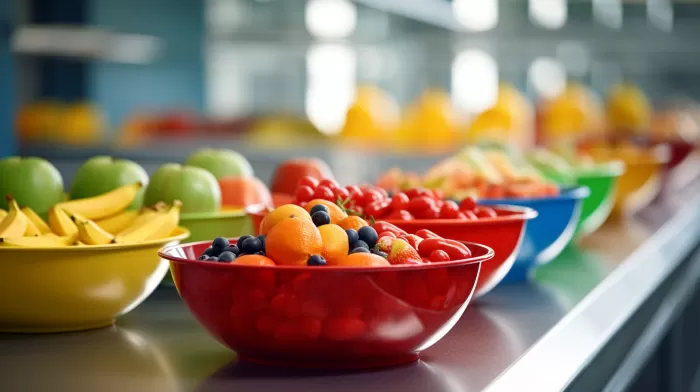School cafeteria meals have been causing some worry lately, especially since studies show that many kids tend to pick pizza, chips, soda, and candy over healthier alternatives available. In some schools, healthy options might even be scarce. To address this concern, researchers at Cornell University established the Behavioral Economics in Child Nutrition Programs (BEN), with the goal of discovering if minor adjustments in cafeteria arrangements could affect the food choices children make.
One fascinating discovery they made was that when fruits were placed in colorful bowls, there was a 104 percent increase in the consumption of these healthy options. According to BEN co-director David Just, “This is a great opportunity to improve kids’ school meal choices. Everyone involved is enthusiastic and eager to help make school lunch exciting as well as nutritious.”
Apart from colorful bowls, BEN researchers have found other cost-effective and straightforward ways to encourage healthier choices in schoolchildren. For instance, moving unhealthy treats to the back of the line in cafeterias and putting ice cream in freezers with opaque doors can also impact children’s food selections positively.
Subtle Changes, Big Impacts
While colorful bowls and rearranging displays might seem trivial, these alterations can considerably affect a child’s choice of food. The success of these small changes underscores the importance of the environment in nudging children towards better food choices. Remember, kids are still in the process of adapting to the world, and their decision-making skills have not yet matured. Unconsciously, they’re more inclined to make choices based on what is attractive or easily accessed.
Subtle alterations to the environment can significantly impact the behavior of kids when it comes to their eating habits. By making healthier options more appealing and less healthy options less accessible, it’s possible to persuade children to consume more nutritious foods without forcing them outright.
Beyond Colorful Bowls and Opaque Freezers
There’s no doubt that colorful bowls and opaque freezers have the potential to encourage kids to choose more fruit and less ice cream. However, some other tactics can also be useful in promoting healthier food choices:
1. Education on nutritional values
A comprehensive curriculum on food and nutrition at school can help children understand the importance of a balanced diet. The knowledge they gain can empower them to make wiser food choices at school and even at home.
2. Parental involvement
Parents play a crucial role in shaping their children’s eating patterns. By providing wholesome meals at home, setting healthy examples, and discussing the importance of nutritious food, parents can foster good eating habits in their children.
3. Creative presentation
An attractive presentation can work wonders in enticing children to try healthier options. Making the healthy food look fun, and visually appealing can pique their interest and prompt them to give those new dishes a fair chance.
4. Regular evaluations
Continuous assessments of food choices and eating habits in school cafeterias can help enlighten stakeholders on the progress being made. These evaluations can also identify areas that need improvement or adjustments to ensure children are making healthier choices.
5. Collaborative efforts
Everyone must work together to create school environments conducive to healthier food choices. School administrators, faculty, parents, and students all play a role in working hand-in-hand to create sustainable systems that promote better eating habits.
6. Consider cafeteria workers’ insights
Cafeteria workers possess valuable first-hand observations on the eating habits and preferences of schoolchildren. Their suggestions could hold the key to creating more effective strategies for encouraging healthier food choices.
Final Thoughts
The mission to encourage healthy eating habits in schools cannot rely solely on colorful bowls and opaque freezers. It requires a multi-faceted approach to ensure children develop lifelong habits that will benefit their overall health. Through early education, parental involvement, creative food presentation, regular evaluations, and collaborative efforts, we can start by guiding our children towards a path of health and wellness.



